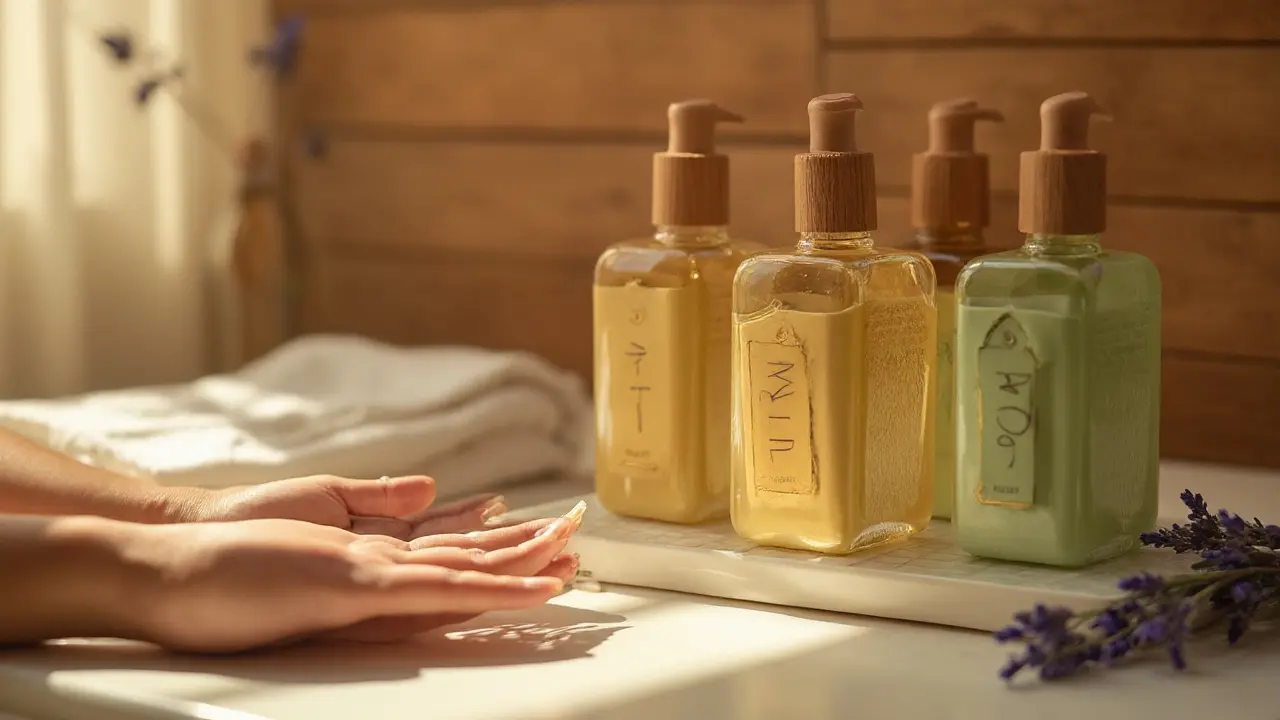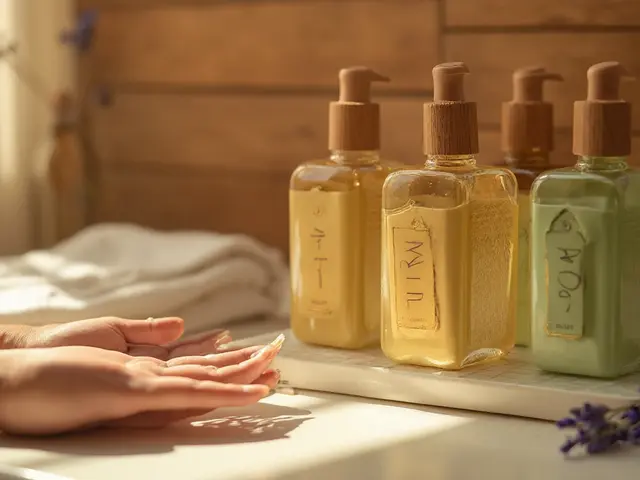Pick the wrong oil and a “relaxing” massage turns into a slip-and-slide, a rash, or sheets ruined by grease. The right oil makes your hands glide, your muscles melt, and your mind settle. This guide shows you exactly which oils work best for relaxation, how to match them to skin type and technique, and how to blend, store, and clean up like a pro.
- Key takeaways: For most relaxation massages, sweet almond, fractionated coconut (MCT), jojoba, sunflower (high-oleic), and grapeseed are reliable bases.
- Quick rule: choose medium glide and medium absorption for 45-60 minutes of calm without constant reapplication.
- Nut allergy? Skip almond and apricot kernel; go for jojoba, fractionated coconut, sunflower, or rice bran.
- Essential oils help, but keep it light: 1-2% dilution for adults; use bergapten-free bergamot and always patch-test.
- Laundry matters: fractionated coconut and jojoba are the most linen-friendly; grapeseed can go rancid fast.
Direct answer: The best all-round oils for a relaxation massage are sweet almond (silky glide), fractionated coconut/MCT (stable, linen-friendly), jojoba (skin-mimicking and hypoallergenic), sunflower high-oleic (budget-friendly workhorse), and grapeseed (light, fast absorption for those who hate feeling greasy). Pick based on allergy status, desired glide time, scent tolerance, and how much linen care you’re willing to do.
How to choose the right oil for a relaxation massage
Relaxation massage isn’t deep tissue. You want steady glide, no tugging, a soft post-massage feel, and a scent that calms not clobbers. Use this short checklist to choose fast.
- Glide and absorption: For 45-60 minutes, pick medium viscosity and medium absorption. Sweet almond and sunflower (high-oleic) are classic. Jojoba gives control with a satin slip. Fractionated coconut offers smooth glide with less residue.
- Skin type: Oily or acne-prone? Jojoba, hemp seed (advanced users), or squalane feel light. Dry or mature skin? Almond, apricot kernel, rice bran, or a bit of shea-infused blend adds cushion.
- Allergies: Avoid nut oils (almond, apricot kernel) if there’s any doubt. Safer bets: jojoba (a liquid wax), fractionated coconut (MCT), sunflower, rice bran, or grapeseed.
- Scent tolerance: If you’re sensitive, choose neutral oils-fractionated coconut, jojoba, rice bran. Olive can smell “salady,” sesame “toasty” unless highly refined.
- Laundry and staining: Fractionated coconut and jojoba wash out best. Grapeseed can oxidize and cling to fibers. Pre-treat linens if you use heavy or unrefined oils.
- Shelf life: If you massage rarely, use long-stable oils like fractionated coconut (2+ years) or jojoba (up to 5 years). Grapeseed can turn within 6 months.
- Budget and availability: Sunflower high-oleic and rice bran are affordable workhorses. Jojoba is pricier but very forgiving and a little goes a long way.
- Sustainability: Jojoba is water-wise, sunflower often locally grown in many regions, and olive-derived squalane is a sustainable upscale option.
Practical rule of thumb: For a smooth, calm massage without reapplying every five minutes, blend 70% sweet almond or sunflower (high-oleic) with 30% jojoba. If allergies or laundry are a worry, swap almond for fractionated coconut. Want more grip for slow, mindful strokes? Add 10% shea butter melted into the base.
Evidence check: Massage alone reduces stress markers. Adding calming scents can nudge results higher. Small randomized studies and reviews (e.g., Complementary Therapies in Clinical Practice, 2018; International Journal of Nursing Studies, 2017) report lavender and citrus (sweet orange) aromatherapy with massage can reduce anxiety and heart rate compared to massage alone. Keep expectations realistic-scent supports the experience; skilled hands and the right glide do the heavy lifting.
Best oils for relaxation: picks, trade-offs, and when to use each
Here’s the short list you can trust. I’ve included glide, scent, allergy notes, shelf life, and where each shines. One size never fits all, so I’ll also tell you when to skip it.
| Oil | Glide/Feel | Absorption | Natural Scent | Allergy Risk | Shelf Life | Linen Staining | Best For | Not For |
|---|---|---|---|---|---|---|---|---|
| Sweet Almond | Silky, classic spa feel | Medium | Mild nutty | Nut allergy risk | 6-12 months | Moderate | General relaxation, dry skin | Nut allergies; acne-prone skin |
| Fractionated Coconut (MCT) | Very smooth, light | Medium-fast | Neutral | Low (not a tree nut) | 2-3+ years | Low (launders well) | Scent-sensitive clients, linens, hot climates | Those wanting a “rich” feel |
| Jojoba | Satin, controlled slip | Medium | Neutral-earthy | Very low | Up to 5 years | Low | Sensitive or acne-prone skin, aromatherapy base | Very tight budgets |
| Sunflower (High-Oleic) | Smooth, non-sticky | Medium | Neutral-light | Low | 12-18 months | Moderate | Affordable bulk, general relaxation | Severely compromised skin barriers |
| Grapeseed | Light, slippy | Fast | Neutral | Low | ~6 months | Higher (oxidizes) | Those who dislike residue, quick evening massages | Long storage; heavy linen use |
| Apricot Kernel | Soft, plush | Medium | Mild | Nut allergy risk | 6-12 months | Moderate | Dry/mature skin, gentle facial work | Nut allergies |
| Rice Bran | Medium-rich, stable | Medium-slow | Neutral | Very low | 12-18 months | Moderate | Budget-friendly, extra cushioning | Very light, minimal feel seekers |
| Squalane (Olive-derived) | Featherlight silk | Fast-medium | Neutral | Very low | 2-3 years | Low | Linen care, facial/neck work, sensitive skin | Full-body long massages (cost) |
| Sesame (Refined) | Warm, nurturing glide | Medium-slow | Mild to toasty | Low | 12 months | Moderate | Ayurvedic-style relaxation, cold days | Scent-sensitive clients |
Best for / not for, at a glance:
- Sweet almond: Best for classic spa feel; not for nut allergies.
- Fractionated coconut: Best for linen care and low scent; not for those who want a heavy, cocooning feel.
- Jojoba: Best for sensitive and acne-prone skin; not for tight budgets if you’re doing lots of full-body work.
- Sunflower (high-oleic): Best all-round budget base; not for people who want ultra-light absorption.
- Grapeseed: Best for minimal residue; not for long storage or heavy linen rotation.
- Apricot kernel: Best for dry/mature skin; not for nut allergies.
- Rice bran: Best for cushion and stability; not for ultra-light preference.
- Squalane: Best for faces, necks, and delicate work; not for cost-conscious full-body massages.
Real-world scenarios:
- Couples’ night at home: Fractionated coconut keeps it simple and sheet-friendly; add 30% jojoba for extra control.
- Sensitive skin client: Go jojoba or squalane with a very mild scent (or no scent).
- Nut-free clinic: Build your base with sunflower + fractionated coconut; keep grapeseed for quick sessions you’ll wash immediately.
- Warm, humid day: Fractionated coconut or squalane won’t feel heavy or sticky.
- Dry winter evening: Almond or rice bran with 10% shea butter melts tension and adds cushion.
Why this works: Relaxation massage is about rhythm and comfort. Medium glide oils maintain flow without drowning tissue feedback. In practice, most therapists blend to hit a sweet spot-enough slip for long effleurage, enough grip to slow down and soothe the nervous system.

Aromatherapy blends and add‑ons that actually relax
Oils are the vehicle; scent can steer the mood. Keep it subtle. For adults, 1-2% total essential oil dilution is usually plenty-about 6-12 drops per 30 ml of carrier. For sensitive folks or pregnancy (with medical okay), stick to 0.5-1%. For safety, many therapists follow Tisserand & Young’s Essential Oil Safety guidelines.
Evidence snapshot: A 2018 review in Complementary Therapies in Clinical Practice reported lavender (Lavandula angustifolia) aromatherapy massage reduced anxiety scores beyond massage alone in several small trials. A 2017 meta-analysis in the International Journal of Nursing Studies found similar benefits with citrus like sweet orange. These are modest effects, but they’re consistent enough to be worth using-lightly.
Relaxation essentials that are beginner-safe when used correctly:
- Lavender (Lavandula angustifolia): classic calm, versatile.
- Sweet Orange (Citrus sinensis): bright, uplifting without being “sharp.”
- Bergamot FCF (bergapten-free): sunny and soothing without phototoxic risk.
- Roman Chamomile (Anthemis nobilis): gentle, great for tension and irritability.
- Cedarwood Atlas (Cedrus atlantica): grounding base note; use low (1 drop per 30 ml).
- Frankincense (Boswellia carterii): meditative, pairs well with citrus and lavender.
- Ylang Ylang (Cananga odorata): floral and languid; very low doses to avoid headache.
Simple blends (measured for 30 ml/1 oz of carrier):
- Soft Sleep: 6 drops lavender + 3 drops sweet orange (1% total). Carrier: 70% fractionated coconut, 30% jojoba.
- Warm Wood: 4 drops cedarwood + 4 drops lavender + 2 drops bergamot FCF (1.0%). Carrier: sweet almond.
- Gentle Calm (scent-sensitive): 2 drops Roman chamomile + 2 drops lavender (0.5%). Carrier: jojoba.
- Sunset Citrus: 5 drops sweet orange + 3 drops frankincense (0.9%). Carrier: sunflower high-oleic.
Pregnancy and medical cautions:
- Check with a clinician if pregnant, breastfeeding, or managing chronic conditions.
- Use 0.5-1% dilution after the first trimester if cleared. Avoid strong stimulants. Stick to gentle oils like lavender and sweet orange.
- For kids and older adults, cut dilutions in half and keep sessions shorter.
Carrier add‑ons to tweak feel:
- Shea butter (melted in at 5-10%): more cushion for slow, soothing strokes.
- Squalane (10-20%): upgrades slip without heaviness; nicer on linens.
- Vitamin E (0.5% tocopherol): slows oxidation and adds a soft finish.
Keep the aromatherapy secondary to touch. If you can smell the blend from across the room, it’s too strong.
Using, storing, and cleaning up: safety, FAQ, and quick fixes
Getting the oil right is half the job. Handling it well makes the massage safer, more pleasant, and less messy.
How much oil to use: For a full back, start with a teaspoon (5 ml) and add a few drops as needed. You should see a soft sheen but still feel some tissue feedback. If your hands skate like ice skates, too much. If you’re dragging skin, add a few drops.
Warming safely: Hands warm the oil fine. If you want pre-warmed oil, place your pump bottle in a mug of warm water for a few minutes. Avoid microwaves and never heat above body temperature. Cooking-style “warming” risks oxidation and burns.
Patch testing and reactions: Dab a drop on the inner forearm and wait 24 hours if you or your partner have reactive skin. Redness, itch, or bumps? Change carriers and skip essential oils. For nut allergies, pick non-nut carriers from the start.
Storage basics:
- Keep oils in amber or opaque bottles, cool and dark.
- Label open dates. Most fresh, cold-pressed oils last 6-18 months; fractionated coconut and jojoba last years.
- Add 0.5% vitamin E to extend life, but don’t fight obvious rancidity-if it smells like putty, crayon, or paint, bin it.
Quick shelf-life guide (typical ranges): Grapeseed ~6 months; sweet almond and apricot kernel 6-12 months; sunflower (high-oleic) 12-18 months; rice bran 12-18 months; fractionated coconut 2-3+ years; jojoba up to 5 years; squalane 2-3 years.
Linen rescue plan:
- Pre-treat fresh stains with a small amount of dish soap or an enzyme-based detergent. Work it in gently.
- Wash hot if your fabric allows. Add washing soda or oxygen bleach for stubborn oils.
- Avoid fabric softeners-they lock in residue. Dry fully in sun when possible.
- If using grapeseed or unrefined oils, wash linens same day to prevent rancidity odor.
Safety notes you’ll be glad you followed:
- Skip broken skin, rashes, or infections. Oil can trap heat and irritants.
- Photosensitivity: If using citrus, use bergapten-free bergamot (FCF). Sweet orange is usually fine at low dilutions. No sunbathing right after any scented massage.
- Medication/conditions: If someone uses blood thinners or has uncontrolled hypertension or diabetes, keep pressure light and scents minimal; check with their clinician when in doubt.
Mini‑FAQ
- Can I use olive oil from the kitchen? You can, but it’s heavy and smells like salad unless very refined. For relaxation, sunflower (high-oleic), fractionated coconut, or almond feel nicer.
- Is baby oil okay? It’s mineral oil. It glides forever and is washable, but it’s not everyone’s favorite skin feel and doesn’t nourish. If you use it, keep aromatherapy minimal and watch for slipperiness.
- What about CBD oils? Legal status and quality vary by region. If you use it, blend into a stable carrier and avoid scented overload. Check local regulations where you live.
- Best carrier for acne-prone skin? Jojoba or squalane, light dilution, and skip heavy butters on the face.
- How do I avoid a scent headache? Use 0.5-1% dilution, ventilate lightly, and choose lavender, sweet orange, or Roman chamomile over heady florals.
Troubleshooting at a glance:
- Too slick, no control: Switch to jojoba or add 10% shea butter; use less product.
- Dragging or tugging: Add a few drops of fractionated coconut or almond to restore slip.
- Post-massage greasiness: Pick grapeseed or squalane; wipe down with a warm, damp towel afterward.
- Sheets smell off: Shorten storage times, avoid grapeseed for heavy linen use, wash the same day with enzyme detergent.
- Skin flushed or itchy: Stop, wipe off with a cool cloth, switch to unscented jojoba, and patch-test before the next session.
Starter kits (keep it simple):
- Nut-free basic: 500 ml fractionated coconut + 250 ml jojoba + vitamin E. Add lavender and sweet orange for light blends.
- Budget-friendly spa feel: 1 L sunflower (high-oleic) + 250 ml jojoba. Optional: 100 g shea butter for winter massages.
- Sensitive skin luxe: 250 ml squalane + 250 ml jojoba; minimal scent.
Last tip: Your hands are the main event. Oils are supporting actors. Choose a base that matches your session length and skin needs, add a whisper of scent if wanted, and keep your laundry plan in mind. That’s how you turn a good massage into the kind that makes someone’s shoulders drop three centimeters in relief.
If you’re still deciding, use this two-step shortcut: 1) If allergies or laundry worry you, choose fractionated coconut + 30% jojoba. 2) If you want a plush spa feel and no nut issues, choose sweet almond + 30% jojoba. Add a 1% lavender/sweet orange blend and you’ve covered comfort, calm, and cleanup in one go. That’s how you find the best massage oils for true relaxation without overthinking it.








Angie Torres
September 9, 2025 AT 14:17American spas should stick to almond oil – it’s the star of the show.
Sharon Chui
September 9, 2025 AT 18:27The way these oils glide across skin reminds me of moonlit rivers, each with its own secret current. I keep an eye on the subtle hints the scent gives, fearing hidden motives in the so‑called "natural" blends. While most folks trust the mainstream, I suspect a quiet agenda behind the hype of cheap sunflower oils. Still, I appreciate a calm blend that doesn’t overwhelm the senses, allowing the mind to wander safely. In the end, the best choice feels like a quiet whisper rather than a shouted advertisement.
Marie-Eve Beaupré
September 9, 2025 AT 22:37The data presented aligns with known physicochemical properties of each carrier. Almond oil shows medium viscosity and moderate absorption, suitable for standard session lengths. Fractionated coconut’s low oxidation rate makes it a practical option for frequent linens washing. Grapeseed’s rapid absorption can lead to quicker drying but raises storage concerns. Overall, the guide offers a balanced view without overstating any single oil’s superiority.
Kristin Briggs
September 10, 2025 AT 02:47From a formulation standpoint, the glide coefficient of jojoba mimics the skin’s own sebum, creating a frictionless interface. Medium‑fast absorption of fractionated coconut translates to reduced re‑application intervals, optimizing therapist efficiency. The lipid chain length in sunflower high‑oleic contributes to oxidative stability, extending shelf‑life under ambient conditions. When discussing allergenicity, the protein‑free matrix of MCT eliminates cross‑reactivity with tree‑nut sensitivities. Moreover, the rheological profile of sweet almond offers a classic satin slip that many clients find comforting. In practice, blending 70% almond with 30% jojoba yields a balanced viscoelastic matrix that supports both effleurage and gentle kneading.
Sean Phoenix
September 10, 2025 AT 06:57Ah, the grand conspiracy of the oil industry – they want us to believe a single splash will solve all stress, as if the Illuminati’s agenda is just a fragrant massage. The pseudo‑philosophy of “slip equals serenity” sounds like a marketing mantra whispered in secret boardrooms. Yet, if you look at the chemistry, it’s just triglycerides doing their job, no hidden mind‑control. I suppose the real mystery is why some people cling to expensive squalane as if it’s a ticket to enlightenment. Still, a dash of lavender on a stable carrier does lighten the mood, even if the ultimate power structures remain unchanged.
Erika Hernández
September 10, 2025 AT 11:07While the grand schemes paint a dramatic backdrop, the real magic is in the tactile experience. A balanced blend of jojoba and fractionated coconut offers a reliable base that won’t betray you mid‑session. Adding just a whisper of lavender can lift spirits without overwhelming the senses. It’s reassuring to know that subtle aromatherapy can coexist with a pragmatic approach to oil selection. Ultimately, the goal is calm, not conspiracy.
vincent ngeso
September 10, 2025 AT 15:17Your analysis hits the mark and gives a clear path forward. I’ll try the recommended blend next time.
Sophie Kerr
September 10, 2025 AT 19:27One must consider the oleochemical profile when selecting a carrier.
Hanna Holmberg
September 10, 2025 AT 23:37When it comes to choosing the perfect carrier for a relaxation massage, the decision matrix is surprisingly nuanced, and a thorough understanding can dramatically elevate both client satisfaction and practitioner efficiency.
First, evaluate the viscosity and slip characteristics: a medium‑glide oil like sweet almond provides that classic spa feel, while fractionated coconut delivers a light, non‑sticky glide that is especially linen‑friendly.
Second, consider the client’s skin type: oily or acne‑prone skin benefits from the non‑comedogenic nature of jojoba or squalane, whereas dry, mature skin thrives with richer bases such as almond or rice bran, possibly enriched with a modest percentage of shea butter for added cushion.
Third, allergenicity cannot be overlooked – for any known nut allergies, skip almond and apricot kernel altogether, opting instead for sunflower high‑oleic, fractionated coconut, or jojoba, all of which pose minimal risk.
Fourth, the scent profile should align with the client’s sensitivity: neutral carriers (fractionated coconut, jojoba) act as excellent vehicles for essential oils, allowing you to introduce calming aromatics like lavender or sweet orange at a modest 1‑2% dilution without overwhelming the olfactory senses.
Fifth, storage stability is paramount: fractionated coconut and jojoba boast shelf lives of two to five years, respectively, making them ideal for practitioners who batch blends; in contrast, grapeseed oxidizes within six months and should be used promptly or stored with antioxidants such as vitamin E.
Sixth, laundry considerations matter for in‑home or clinic settings – oils that stain fabric minimally (fractionated coconut, jojoba) reduce post‑session cleanup, whereas grapeseed and unrefined oils may require immediate laundering with enzyme‑based detergents to prevent rancid odors.
Seventh, cost efficiency: sunflower high‑oleic and rice bran provide affordable bulk options without compromising performance, while premium choices like squalane or high‑grade jojoba deliver superior slip with a higher price point, suitable for upscale settings.
Eighth, sustainability: jojoba’s water‑wise cultivation and locally sourced sunflower oil can appeal to eco‑conscious clients seeking greener practices.
Ninth, blending strategy – a proven formulation is 70% almond or sunflower (high‑oleic) with 30% jojoba; this mixture balances slip, absorption, and skin‑mimicking qualities, and can be further customized with a splash of shea butter (5‑10%) for extra cushioning during slow, mindful strokes.
Tenth, essential oil integration – keep the total essential oil concentration under 2% for adults, and under 1% for sensitive populations, always performing a patch test 24 hours prior to full‑body application.
Finally, practical application tips: start with a teaspoon of carrier for a full‑back massage, warm the oil gently using a warm water bath (never microwave), and reapply sparingly if the skin begins to feel “slick.” By systematically weighing these variables, you’ll curate a bespoke oil blend that maximizes relaxation, minimizes irritation, and keeps the linens fresh, ensuring every session feels like a tranquil escape rather than a slip‑and‑slide disaster.
Shaun Chooi
September 11, 2025 AT 03:47That deep dive really ties together the science and the art of massage oil selection, and I love how it emphasizes both client comfort and practical logistics. Your point about sustainable sourcing resonates – it’s a win‑win for eco‑awareness and client trust. I’ll definitely experiment with the 70/30 almond‑to‑jojoba blend and keep the essential oil ratio low as you suggested. Thanks for the comprehensive guide – it makes the whole process feel approachable and professional.